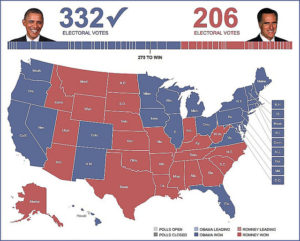
2012 electoral map
From the beginning of this election cycle, we have focused on cold hard math, because that’s how you know who is winning and who is likely to prevail. In a presidential election, the cold hard math is the state count of electoral votes. With just one day left before the 2016 elections, and after all the controversies, conspiracies and insults, plus widespread early voting, most of the electoral vote models show Hillary Clinton winning decisively over Donald Trump. These models include the Los Angeles Times with a whopping 352 electoral votes for Clinton, Real Clear Politics with 301 EVs for Clinton when “toss-up” states are assigned, and virtually every other scientific prediction showing Clinton well ahead even before assigning the toss-ups.
The oft-neglected fact about this election is that, since electoral votes are based on state population, the Republicans have a basic electoral problem: they are more popular in states with fewer people and thus fewer electoral votes. In essence, the GOP had a steep uphill climb before this campaign even began.
We have to start with California. It’s by far the nation’s most populous state, thus it has by far the most electoral votes at 55. It’s also one of the nation’s bluest states. Accordingly, the Democrats start off every presidential election with more than 20% of the 270 electoral votes needed to win. Next, the Democrats have New York (29 EVs) in their column. 55 + 29 = 84 EVs, or more than 31% of the total needed to win. Add New Jersey (14 EVs) and Massachusetts (11 EVs) and the Dems are up to more than 40% of the total needed, with just four states. Illinois (20 EVs) is also reliably blue of late, bringing the Democrats’ total to 129 electoral votes, or more than 47% of the way to victory, with only five states.
Republicans have nothing like this in comparison. The best that Republicans can do is Texas, with 38 EVs. However, even Texas is starting to turn purple, and may become a toss-up state soon (it would require a separate post to discuss why Democrats are doing well in states like Texas, Arizona and Nevada this year, but thus far the short answer seems to be women and Latino voters). Thereafter, many of the solid Republican states have small populations and thus small EV numbers, including Wyoming (3 EVs), Oklahoma (7 EVs), Alabama (9 EVs), Mississippi (6 EVs), Nebraska (5 EVs), etc.
This is why you hear so much about “battleground,” “toss-up” or “swing” states this year and in recent elections. Unfortunately for Republicans, Florida, which at 29 EVs is tied with New York for third most populous, is not a solid Republican presidential state. It’s a battleground state, which the Democrats won in 2012 and 2008, as well as 1996 (let’s not even talk about 2000). Likewise, Ohio (18 EVs) is a battleground state, having flip-flopped between Democrats (2012, 2008) and Republicans (2004, 2000, 1996) in recent elections. North Carolina (15 EVs) has this same track record as Ohio.
The problem for Republicans is that, due to this cold hard math, the analysts say that Donald Trump must win virtually every “battleground” state this year (such as Ohio, Florida, North Carolina, Nevada, Colorado and New Hampshire), plus a normally blue state like Pennsylvania (20 EVs) or Michigan (16 EVs) to win. It’s not impossible, but as the election models are predicting, it’s nearly impossible. If the models hold through tomorrow night, Republicans are going to have to have another serious soul-searching, and some significant changes in their policies and their treatment of many groups in America, if they want to be more competitive in the 2020 presidential election.
Photo by Ron Cogswell, used under Creative Commons license. https://is.gd/DKmBKE


